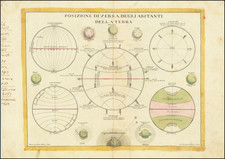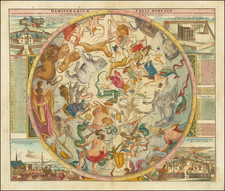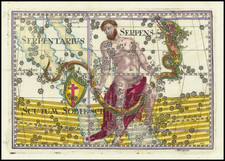A Remarkable Portrayal of the Leonids, made by the "Audubon of the Sky", Etienne Trouvelot.
This is a beautiful color lithograph showing a meteor shower, made by Etienne Trouvelot and relating his observations made one night in November of 1868. The chromolithograph was published as part of Trouvelot's Astronomical Drawings set of 15 plates by Charles Scribner's Sons in 1882.
Trouvelot's drawings are known as some of the best images of the sky ever made. Trouvelot's work was very important at the time, as it provided important images of the stars, planets, and phenomena of the sky at a time when popular interest in astronomy was growing, but photography had not yet become advanced enough to capture such dark images. Trouvelot's images are recognized as the last of the great images of the night sky that surpassed the photography of their day.
"Stars were falling and random, speeding along brief vectors from their origins in night to their destinies in dust and nothingness" -- Cormac McCarthy's Description of the Leonides
The present image shows the Leonids, a meteor shower that occurs regularly in November. As the earth crosses the trajectory of the comet Tempel-Tuttle, the debris left behind by the passage of the comet rains down on the earth. The shower draws its name for the constellation Leo, from which it is radiant.
The Leonids are strongest approximately once every 33 years, coinciding with the period of its parent comet. The 1833 shower first drew popular attention to the phenomena and was particularly strong in North America. This event featured often in the literature of the time, Faulkner cites 1833 as "Yr. stars fell" in Go Down, Moses. Trouvelot completed his work two years after the large 1866 event and portrayed meteors that fell over the course of five hours.
Trouvelot provides a useful description of the phenomena shown as follows in his Trouvelot Astronomical Drawings Manual:
A partially ideal view of the November Meteors, combining forms observed at different times during the night of Nov. 18th, 1868. It is not, however, a fanciful view, since a much larger number of meteors were observed falling at once during the shower of November, 1833, and at other times. The locality of the observation is shown by the Polar Star seen near the centre of the Plate, and Cassiopeia’s Chair at the left. The general direction of the paths of the meteors is from the north-east, the radiant point of the shower having been in the constellation Leo, beyond and above Ursa Major. While the orbits of the meteors are, in general, curved regularly and slightly, several are shown with very eccentric paths, among them one which changed its course at a sharp angle. In the upper left-hand corner appear two vanishing trails of the “ring-form,” and several others still further transformed into faint luminous patches of cloud. Red, yellow, green, blue and purple tints were observed in the meteors and their trails, as represented in the Plate.
Rarity
Trouvelot's prints were originally intended for the astronomical and scientific community and most of the larger US observatories purchased copies of the portfolio. In 2002, B.G. Corbin undertook a census to determine the number of surviving copies of the complete set of 15 prints and was only able to confirm the existence of 4 complete sets.
Trouvelot (1827-1895) was born in Guyencourt, Aisne, France. During his early years he was apparently involved in politics and had Republican leanings. Following a coup d'état by Louis Napoleon in 1852, he fled or was exiled with his family to the United States, arriving in 1855. They settled in the town of Medford, Massachusetts, where he worked as an artist and nature illustrator. In both 1860 and '70 census, his occupation is listed as lithographer.
Trouvelot had an interest as an amateur entomologist. In the U.S., silk-producing moths were being killed off by various diseases. Trouvelot brought some Gypsy Moth egg masses from Europe in late 1866 and was raising gypsy moth larvae in the forest behind his house. Trouvelot apparently understood the danger posed by the Gypsy Moths and housed them under netting. Unfortunately, an egg mass went missing during a storm in 1869. He immediately realized the potential problem he had caused and notified some nearby entomologists, but nothing was done. This story has been called into question, based on earlier reports Trouvelot made that his netting had holes in it large enough for robins to fit through and eat his caterpillars.
Shortly following this incident, Trouvelot lost interest in entomology and turned to astronomy. In this field he could put his skills as an artist to good use by illustrating his observations. His interest in astronomy was apparently aroused in 1870 when he witnessed several auroras.
When Joseph Winlock, the director of Harvard College Observatory, saw the quality of his illustrations, he invited Trouvelot onto their staff in 1872. In 1875, he was invited to the U.S. Naval Observatory to use the 26-inch refractor for a year. During the course of his life he produced about 7,000 quality astronomical illustrations. 15 of his most superb pastel illustrations were published by Charles Scribner's Sons in 1881. He was particularly interested in the Sun, and discovered "veiled spots" in 1875. Besides his illustrations, he published about 50 scientific papers.
In 1878, Trouvelot and his son traveled to Creston, Wyoming Territory, to observe the total eclipse of the Sun on July 29.
By 1882, Trouvelot had returned to France and joined the Meudon Observatory. He worked there under Jules Janssen, a leading solar astronomer. However, Trouvelot resented the cloudy French sky, which impeded his observations. He traveled with Janssen to the Caroline Islands in the South Pacific to observe the total eclipse of 1883 and attempt to discover the phantom intra-Mercurial planet.
Trouvelot died at Meudon on April 22, 1895. At the time he was working on a monograph of Mars. His son, George, hoped to find a publisher for Etienne's drawings of Mars, but was unsuccessful. The whereabouts of almost all of the drawings left by Trouvelot to his family are currently unknown.










![[The centre of this Slider is to be placed by a Thread or Pin over the centre of the respective Planisphere for any Operation]](https://storage.googleapis.com/raremaps/img/small/65557.jpg)

![[Perseus]](https://storage.googleapis.com/raremaps/img/small/83167.jpg)

![[ Twin Hemispheric Maps of the Constellations ] Hemisphere Celeste Septentrional [with] Planisphere Celeste Meridional](https://storage.googleapis.com/raremaps/img/small/103356.jpg)